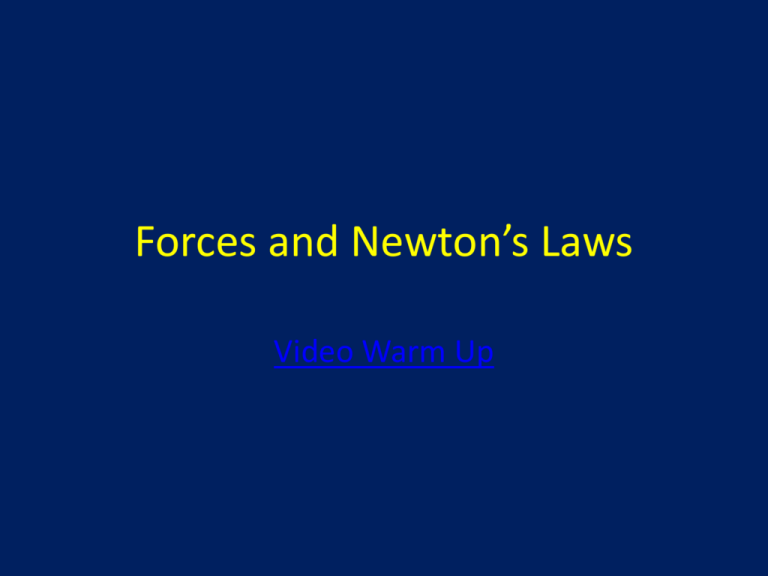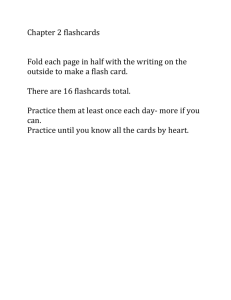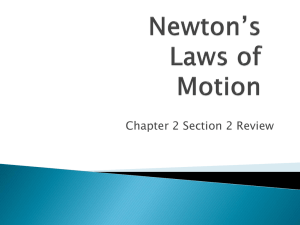balanced force - 7sciencewithmcmillan
advertisement

Forces and Newton’s Laws Video Warm Up What is a force? • A force is a push or pull that causes an object to move, stop, or change direction. • In physics, a force is anything that makes an object accelerate. Balanced and Unbalanced Forces • Forces occur in pairs and they can be either balanced or unbalanced. Balanced Forces • Balanced forces do not cause change in motion or acceleration. • They are equal in size and opposite in direction. I need 2 volunteers! Balanced Forces • Example 1: The floor pushes upward and gravity pulls downwards on the person. • Example 2: The table pushes upward on the book and gravity pulls downward on the book. Unbalanced Forces • An unbalanced force acting on an object will change the object’s motion. • An unbalanced force can cause an object to start moving, stop moving, or change direction. • The object will accelerate in the direction of the greater force. Unbalanced Force Examples Example 1: Gravity is a constant force. The parachute is working against the force of gravity. Example 2: The person’s finger pushes the toy truck because it is using a greater force than the toy truck pushing against the finger. Calculating the Net Force • Net force is the overall force acting on an object. It is a combination of the magnitude and direction. - Magnitude = the difference between 2 forces - Direction = direction of the largest force Calculating the Net Force • If there is a net force acting on the object, the force is unbalanced. • To calculate the net force, you subtract the weaker force from the greater force. • For example, in this tug of war, the net force is 3N (Newtons) to the left, because 5N-2N = 3N. What is the net force in these examples? 125N – 75N = 50N If the object isn’t moving or changing direction, the net force acting on it is 0 N. (F – F = 0N) 10N – 7N = 3N What is the net force in this example? To find the net force, subtract opposing sides and add same sides. 5N up and 5N down cancel each other. 10 N – 5 N = 5 N The greater force is going left. What is the net force in this example? To find the net force, subtract opposing sides and add same sides. 10 N – 5 N = 5 N up 10 N – 5 N = 5 N right Draw an arrow for the direction of movement in these examples. Gravity As a Force • We encounter the force of gravity every day. • Gravity = the force that acts to pull objects straight towards the center of the earth. • As an object falls, its velocity changes at a rate of 9.8 m/s2. What is this an example of? ACCELERATION! (It accelerates as it falls.) Make a Prediction • Does the weight of an object affect how fast it accelerates as it falls? • What will hit the ground first? A) bowling ball B) golf ball C) They will hit at the same time https://PBS Video - Experiment Friction As a Force • Friction is the force that one surface exerts on another when the two rub against each other. • Friction acts in a direction opposite to the object’s direction of motion. • Without friction an object would continue to move at a constant speed forever. Friction As a Force • Friction is increased by the amount of surface area the object has in contact with the surface. • For example, tires with more surface area have better traction on the road. • Friction causes objects to slow down or stop. Sir Isaac Newton & Newtons of Force (N) • The unit for measuring force is called the Newton. It was named after the famous scientist, Sir Isaac Newton (1643-1727). • Discovered the law of gravity. • Discovered the 3 Laws of Motion. Newton’s Laws of Motion = Laws that describe the motion of all objects on the scale we experience in our everyday lives. 1) An object in motion tends to stay in motion and an object at rest tends to stay at rest unless acted upon by an unbalanced force. 2) Force equals mass times acceleration (F = m*a) 3) For every action there is an equal and opposite reaction. Newton’s First Law of Motion An object at rest tends to stay at rest and an object in motion tends to stay in motion unless acted upon by an unbalanced force. Newton’s First Law of Motion Basically, an object will “keep doing what it was doing” unless acted on by an unbalanced force. If the object was sitting still, it will remain stationary. If it was moving at a constant velocity, it will keep moving. It takes force to change the motion of an object. Then why don’t moving objects keep moving forever??? Things don’t keep moving forever because there’s almost always an unbalanced force acting upon it. A book sliding across a table slows down because of the force of friction. If you throw a ball upwards it will eventually slow down because of the force of gravity. What about in space? In outer space, away from gravity and any sources of friction, a rocket ship launched with a certain speed and direction would keep going in that same direction and at that same speed forever. Newton’s Second Law Force equals mass times acceleration. F = ma Acceleration: a change in velocity (changing speed or changing direction). What does F = m*a mean? Force is directly proportional to mass and acceleration. Imagine a ball of a certain mass moving at a certain acceleration. This ball has a certain force. Now imagine we make the ball twice as big (double the mass) but keep the acceleration constant. F = ma says that this new ball has twice the force of the old ball. More about F = ma If you double the mass, you double the force. If you double the acceleration, you double the force. What if you double the mass and the acceleration? (2m)(2a) = 4F Doubling the mass and the acceleration quadruples the force. So . . . what if you decrease the mass by half? How much force would the object have now? What does F = ma say? F = ma basically means that the force of an object comes from its mass and its acceleration. Something very massive (high mass) that’s changing speed very slowly (low acceleration), like a glacier, can still have great force. Something very small (low mass) that’s changing speed very quickly (high acceleration), like a bullet, can still have a great force. Something very small changing speed very slowly will have a very weak force. Newton’s Third Law For every action there is an equal and opposite reaction. What does this mean? For every force acting on an object, there is an equal force acting in the opposite direction. Example #1: Right now, gravity is pulling you down in your seat, but Newton’s Third Law says your seat is pushing up against you with equal force. This is why you are not moving. There is a balanced force acting on you– gravity pulling down, your seat pushing up. 3rd Law Example #2: Flying gracefully through the air, birds depend on Newton’s third law of motion. As the birds push down on the air with their wings, the air pushes their wings up and gives them lift. Other examples of Newton’s Third Law Example #3: The baseball forces the bat to the left (an action); the bat forces the ball to the right (the reaction). 3rd Law The reaction of a rocket is an application of the third law of motion. Various fuels are burned in the engine, producing hot gases. The hot gases push against the inside tube of the rocket and escape out the bottom of the tube. As the gases move downward, the rocket moves in the opposite direction. Think about it . . . What happens if you are standing on a skateboard or a slippery floor and push against a wall? You slide in the opposite direction (away from the wall), because you pushed on the wall but the wall pushed back on you with equal and opposite force.






